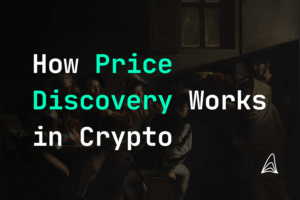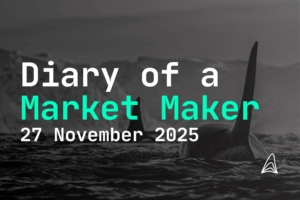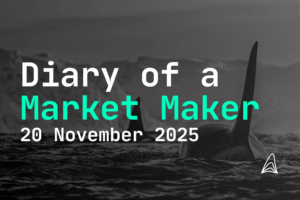
What Are Automated Market Makers (AMMs)?
- Jakob Brezigar
- Last updated: 20.February 2024
- Reading time: 8 min
Navigating the DeFi world without understanding Automated Market Makers (AMMs) is like trying to bake a cake without a recipe—possible, but likely to result in a mess. At their core, crypto AMMs are the heart of decentralized finance (DeFi), revolutionizing trading by enabling transactions without traditional order books. These algorithm-driven platforms maintain market liquidity, allowing for instant trades by automatically setting prices between crypto assets, thereby baking the perfect cake of seamless exchange in the ever-evolving DeFi ecosystem.

Table of Contents
What is AMM in crypto?
Automatic markets makers (AMMs) are a form of decentralized exchanges using algorithmic “money robots”, making it easier for a person to buy a crypto asset. Instead of interacting directly to the user with a typical orderbook, the user trades directly with AMM users.
How to make money with AMM?
Any one who can use the Internet to buy tokens can become a liquidity provider by supplying tokens to the AMM liquidity pool. Providers typically get money from liquid assets if they offer tokens in pools. This charge is imposed on trades that participate within liquidity pools.
What is an example of an AMM?
AMMs can be incorporated in any organization as long as the requirement of the smart contract is fulfilled. AMM examples are Uniswap, Balancers and Curves.
DeFi has reshaped the financial landscape with new technologies and models. Central to its surge is the Automated Market Maker (AMM). The concept of an automated market maker crypto is gaining traction as a pivotal component in the DeFi realm. Here’s a deep dive into how crypto amms function and why they are vital in the world of DeFi.
Key Takeaways
- AMMs automate trading in DeFi, allowing seamless asset exchanges without traditional order books by using algorithms to set prices.
- Orcabay’s human-driven market making offers adaptability and real-time response, outperforming AMM’s rigid algorithms in volatile crypto markets.
- Liquidity pools and providers are essential, enabling immediate trading while earning transaction fees, thus stabilizing and enriching the DeFi ecosystem.
- Security concerns in AMMs, such as smart contract vulnerabilities and impermanent loss, underscore the importance of thorough understanding and caution in DeFi investments.
- Innovations like Dynamic, Proactive, and Virtual AMMs aim to enhance market efficiency, security, and adaptability, signaling the continuous evolution of the DeFi space.
Why Market Makers May be a Better Option Than the Automated Market Makers (AMMs)
In the rapidly evolving world of blockchain and cryptocurrencies, the nuanced approach offered by Orcabay’s market making strategies significantly outperform the rigid algorithms of the automated market maker (AMM). Through a bespoke case study, we observed that Orcabay’s tailored market making not only adapts in real-time to the volatile crypto markets but also anticipively manages liquidity in a way that AMMs can’t.
This customization is crucial for crypto exchanges, DeFi platforms, and DEXs, where the market’s dynamism and complexity demand more than just algorithmic predictions. Unlike AMMs, which follow pre-set rules, Orcabay’s human-driven insights allow for strategic adjustments based on emerging trends and anomalies. This approach ensures more stable and efficient markets, enhances user trust, and mitigates slippage, ultimately benefiting all parties within the blockchain ecosystem.
Orcabay’s expertise in non-automated market making showcases the importance of flexibility and human oversight in navigating the intricacies of the crypto world, offering a more reliable and responsive solution to liquidity and trading challenges.
Decentralized Finance and the Role of Automated Market Makers (AMMs)
DeFi represents the cutting edge of financial innovation on decentralized exchanges. With each passing day, the DeFi space broadens, and central to this metamorphosis stands the automated market maker (AMM crypto).
As we immerse ourselves deeper into the DeFi ecosystem and the growing realm of decentralized crypto assets and exchanges, understanding the intricacies of automated market makers becomes imperative.
They not only signify a departure from traditional finance mechanisms on centralized exchanges but also present the future trajectory of decentralized transactions in crypto markets.
This movement has been accelerated by the increasing appeal of crypto trading in the decentralized exchange landscape.

How does an Automated Market Maker (AMM) Work?
In the financial realm, traditional exchanges have long been anchored by bid and ask order books. These mechanisms necessitate a counterparty for every transaction, making the trading process somewhat dependent on market participants’ availability and intentions.
Unlike their traditional exchange and market maker counterparts, an automated market maker operates on a smart contract that allows traders to initiate trades directly without a counterparty.
Enter automated market makers, a groundbreaking deviation from this age-old market maker model. Unlike their traditional counterparts on centralized exchanges, automated market makers operate without the dependency on conventional order books.
Instead, they harness the power of algorithmic equations to determine the value and price of digital assets dynamically. So, when a trader steps forth with an intention to buy and sell orders or trade assets, they’re no longer mired in the search for a matching counterparty.
The AMM, with its built-in algorithm, promptly presents the exchange rate, drastically simplifying and expediting the trade on the decentralized exchange.
Why is Liquidity so Important?
Liquidity denotes the ease with which assets can be traded without inducing significant price changes. A market with more liquidity ensures that transactions can be executed seamlessly. Such markets prevent excessive price deviations, offer competitive rates, and cultivate an environment of trust.
In contrast, markets devoid of sufficient liquidity can experience unpredictable and often drastic price changes, which can deter potential traders from venturing into them.

What are Liquidity Pools and Liquidity Providers?
In the world of decentralized finance, particularly within automated market maker systems, two concepts stand out: liquidity pools and liquidity providers. A liquidity pool can be visualized as a vast reservoir of funds and liquidity, securely stored within asset-specific smart contracts.
Unlike traditional order books used by centralized exchanges, decentralized exchanges leverage these liquidity pools to provide immediate liquidity for traders. This means that when a trader wishes to buy or sell a specific asset, they are interacting with this pool rather than with another individual trader.
Liquidity providers, often abbreviated as LPs, are the backbone of these liquidity pools. They can be individuals or larger entities that supply the assets to these pools.
In return for their contribution, liquidity providers earn a share of the transaction fees generated from trades within the pool. This offers them a potential source of passive income. The total assets within a liquidity pool, often referred to as its ‘depth’, determine the size of a trade that can be executed without causing significant price fluctuations.
How AMM Maintains Liquidity in a Liquidity Pool?
For an automated market maker (AMM) to function effectively and optimally, maintaining consistent and high liquidity in its liquidity pool is pivotal.
This liquidity pool serves as the central mechanism in which assets are stored and traded. The devised strategy to ensure the consistent flow of assets into the liquidity pool involves transaction fees, taken every time a digital asset is traded.
Every trade executed on a DeFi platform incurs a fee. A percentage of this fee gets channeled directly to the LPs, proportional to their share in the liquidity pool. This regular inflow of assets acts as an incentive for the liquidity pool providers, encouraging them to retain their assets within the liquidity pool, thus guaranteeing sustained liquidity.
This process of providing liquidity ensures the health and robustness of the liquidity pool’s total assets in the decentralized exchange.

Constant Product Market Maker (CPMM)
The CPMM model, a foundational concept within AMMs, operates a fixed constant, on the equation x*y=k, implying that the product of two asset quantities remains unaltered. This mathematical formula of simplicity ensures that as the quantity of one asset diminishes, the value of the other escalates, and the inverse is true as well.
The CPMM model’s predictability first asset, is its strength. However, in instances with restricted liquidity, traders might witness pronounced price deviations or slippage in price assets.

Yield Farming Opportunities on AMMs
Within the vast DeFi terrain lies an array of investment strategies, with yield farming emerging as a prominent one. Yield farming involves strategically allocating capital across different trading pairs to maximize returns.
Beyond the conventional trading fees, many AMMs offer additional incentives in the form of free tokens to LPs. These bonus rewards can significantly amplify earnings.
What Are the Different Automated Market Maker (AMM) Models?
The world of DeFi and, more specifically, AMMs on decentralized exchanges is teeming with diverse models, each catering to unique needs and specific scenarios.
While the Constant Product Market Maker (CPMM) model has carved a niche for itself due to its simplicity and effectiveness, it’s just one of the numerous strategies in the vast AMM universe. Numerous other models have been developed, many of which are designed with an emphasis on stablecoin transactions. Their primary objective is to preserve price stability and trade digital assets while ensuring that trades result in negligible slippage.
To achieve this, these models deploy intricate algorithms tailored to track and respond to market dynamics, particularly when dealing with assets that are pegged to a stable value, such as fiat currencies.

Arbitrage Opportunities In Liquidity Pools
The vast and interconnected landscape of financial markets, especially in the realm of DeFi, sometimes gives rise to intriguing pricing anomalies.
Owing to differences in liquidity, volume, or even user behavior, there may be momentary price disparities between AMMs and conventional trading platforms. These deviations from the fair market price are nothing less than golden opportunities for eagle-eyed traders who have an appetite for arbitrage.
By diligently spotting these pricing differences between multiple exchanges and trading pairs, traders can exploit the situation by purchasing assets at a more favorable, reduced price on one platform and subsequently selling them at a higher price on another, thus locking in the difference as profit.
Beyond individual gains, this same arbitrage trading activity serves a larger purpose: it plays a pivotal role in restoring and maintaining price equilibrium across diverse platforms.
Popular DeFi Platforms That Use Automated Market Makers
Names like Uniswap and Balancer have become emblematic of the DeFi realm, predominantly due to their reliance on AMM-centric trading protocols.
With their staggering total value locked (TVL), these platforms epitomize the efficacy and dependability of the AMM framework.
Their widespread embrace by the DeFi community accentuates the growing faith in AMM-centric decentralized platforms.
Why Are AMMs Becoming Popular?
Automated market makers are resonating deeply within the DeFi sphere and the broader decentralized exchange landscape. Their innate capability to source liquidity for even lesser-known tokens offers unparalleled advantages.
Furthermore, the AMM paradigm empowers users by democratizing liquidity providers’ income opportunities to other users. By allowing virtually anyone to partake as a liquidity provider, it fosters inclusivity. The blend of user empowerment, coupled with heightened market efficacy, has catapulted AMMs as the linchpin of DeFi advancements.

Improving AMM Models With Hybrid, Dynamic, Proactive, and Virtual Solutions
The trajectory of AMMs isn’t linear. Visionaries in the domain constantly strive to enhance and adapt these models. Hybrid models are surfacing, endeavoring to meld the attributes of conventional order books with automated market makers on decentralized exchanges.
Then there are Dynamic AMMs, which adjust their tactics based on real-time market insights. Proactive models are diving into anticipatory adjustments, while virtual AMMs are pushing the envelope regarding scalability and efficiency.
AMM Security Issues
The allure and transformative potential of an automated market maker in the DeFi landscape is undeniable. However, as with most innovative technologies, they come with their fair share of vulnerabilities.
Smart contracts, particularly those managing liquidity pools in a smart contract framework, are critical elements that need continuous oversight.
While smart contracts are engineered to revolutionize trading and provide liquidity, imperfections in the smart contract or unforeseen market turbulences can be detrimental. There have been instances where poorly designed or audited smart contracts became easy targets for hackers.
Additionally, unexpected market events, such as massive liquidations or price manipulations, could result in what’s known as “impermanent loss” for liquidity providers. This type of loss occurs when the price of a token inside a liquidity pool deviates substantially from the market price.
Hence, for anyone considering becoming a liquidity provider or interacting with AMMs, a thorough understanding of deep liquidity, meticulous research, and cautious strategy formulation are crucial.
Safeguarding one’s investment in the volatile realm of DeFi requires an equal mix of enthusiasm and caution.

Dynamic Automated Market Maker (DAMM)
DAMMs stand as the vanguard in the ever-evolving world of automated market makers. By closely monitoring market behaviors, they recalibrate their algorithms to offer more accurate and competitive pricing.
The main advantage lies in their ability to dampen the adverse impact of large or sudden trades, which can disrupt market equilibrium.
By doing so, DAMMs not only enhance the overall health and stability of the market but also instill confidence among traders.
Proactive Market Maker (PMM)
Moving a step beyond the reactive nature of many existing models, PMMs are the visionaries of the AMM world. They don’t just adapt; they anticipate. Using advanced algorithms and possibly integrating machine learning techniques, PMMs analyze historical data and current market trends to forecast potential shifts.
Based on these predictions, they proactively tweak their strategies, ensuring that the current market price remains as stable as possible even before any significant change occurs.
This proactive approach aims to offer traders better exchange rates and a smoother trading experience. As PMMs continue to mature, their anticipatory model may very well set a new standard for automated market-making in the future.

Virtual Automated Market Makers (vAMM)
VAMMs are more than just another step in the evolution of AMMs; they represent a groundbreaking leap. Harnessing the power of virtual mechanisms and possibly integrating with off-chain solutions, vAMMs are designed to operate beyond the constraints that bind traditional AMMs.
They are conceptualized to handle vast volumes, deliver heightened performance, and offer a broader range of utilities without compromising on security or decentralization. As we navigate deeper into the age of DeFi, vAMMs could potentially serve as the foundational pillars, heralding a new era where scalability and efficiency are not just desired but are the norm.

Summary
The article explores the intricacies of Automated Market Makers (AMMs) in the DeFi landscape, highlighting their role in providing liquidity and facilitating seamless trading strategies without traditional order books. It contrasts Orcabay’s human-driven market making strategies with the algorithmic approach of AMMs, emphasizing the benefits of adaptability and real-time responses to market changes. Additionally, it delves into liquidity pools, the importance of liquidity, yield farming, and various AMM models, while also touching on security issues and innovations like Dynamic, Proactive, and Virtual AMMs, underscoring their evolution and potential in improving market efficiency and security.

Jakob Brezigar
Jakob, an experienced specialist in the field of cryptocurrency market making, boasts an extensive international presence. With Orcabay, he has skillfully managed major operations and deals for a wide array of global stakeholders.



